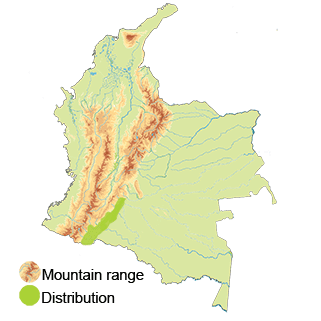Buff-tailed Sicklebill
Appearance: The Buff-tailed Sicklebill is a medium-sized hummingbird with a distinctive appearance. It has a long, decurved bill that gives it its name, a fawn-colored or buff-colored throat and breast, and iridescent green or bronze plumage on its back and wings. The male and female Buff-tailed Sicklebills exhibit sexual dimorphism, with males displaying more vibrant colors and longer tail feathers compared to females.
Habitat: Buff-tailed Sicklebills inhabit montane forests, cloud forests, and humid, mossy mountainous areas in the Andes of Colombia. These hummingbirds are adapted to high-altitude environments characterized by cool temperatures, rich vegetation, and an abundance of flowering plants that provide nectar, their primary food source.
Behavior: Buff-tailed Sicklebills are known for their agile flight patterns, which enable them to navigate dense vegetation and access flowers for nectar. They have specialized bills that allow them to feed on long tubular flowers, using their long tongues to reach the nectar deep within the flower
Breeding: During the breeding season, male Buff-tailed Sicklebills perform elaborate courtship displays to attract females. Nesting occurs in concealed locations, such as in dense vegetation or on tree branches, where the female incubates the eggs and cares for the young chicks.
Conservation status: The Buff-tailed Sicklebill is not considered threatened.
Distribution
Eastern Andes: The Eastern Andes, including the Cordillera Oriental, are another important region in Colombia where the Buff-tailed Sicklebill can be found.
- Mountainous areas with high levels of precipitation and abundant flowering plants support populations of this species in the Eastern Andes.
Taxonomy
The Buff-tailed-Sicklebill (Eutoxeres condamini)
- Kingdom: Animalia
- Phylum: Chordata
- Class: Aves (Birds)
- Order: Caprimulgiformes
- Family: Trochilidae
- Genus: Eutoxeres
- Species: Eutoxeres condamini
Vocalization
The Buff-tailed Sicklebill, like many hummingbirds, is not particularly known for its complex vocalizations. The Buff-tailed Sicklebill may produce simple vocalizations that are often described as soft chirps or whistles.
The vocalizations of the Buff-tailed Sicklebill are primarily used for communication within their social groups, during courtship displays, or to establish territorial boundaries. These vocalizations are typically short and simple, serving as a means to convey basic messages rather than intricate songs like those of many songbirds.
While the exact details of the vocal repertoire of the Buff-tailed Sicklebill may vary, observers have reported soft, high-pitched chirps or brief trills as common sounds produced by this species. These calls are often used in conjunction with visual displays, such as aerial maneuvers or fluttering movements, as part of their behavioral repertoire.





